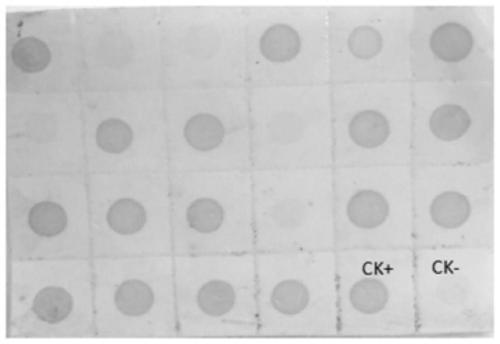Hybridoma cell line secreting monoclonal antibody against rice tumor dwarf virus and application of monoclonal antibody
A technology of rice tumor dwarf virus and hybridoma cell line, which is applied in the biological field and can solve the problems of compound infection of viruses, unsuitability for large-scale sample detection in the field, and high cost
- Summary
- Abstract
- Description
- Claims
- Application Information
AI Technical Summary
Problems solved by technology
Method used
Image
Examples
Embodiment Construction
[0015] The hybridoma cell line 11B6 secreting monoclonal antibody resistant to rice dwarf virus was deposited in the General Microbiology Center of China Microbiology Culture Collection Management Committee, Institute of Microbiology, Chinese Academy of Sciences on December 15, 2017. The preservation number is CGMCCNo.14897. It can secrete anti-rice Monoclonal antibody against tumor dwarf virus.
[0016] Anti-rice tumor dwarf virus monoclonal antibody ascitic fluid indirect ELISA titer reaches 10 -8 , the type and subclass of the antibody are IgG1 and kappa chains, which can have a specific immune reaction with the 47kDa coat protein of rice tumor dwarf virus. Using ACP-ELISA and dot-ELISA methods, it was found that the monoclonal antibody detected the diseased leaves of rice plants infected with RGDV The sensitivity reached 1:327 680 and 1:20 480 times dilution (w / v, g / mL) respectively.
[0017] The monoclonal antibody against rice tumor dwarf virus has specific immune react...
PUM
 Login to View More
Login to View More Abstract
Description
Claims
Application Information
 Login to View More
Login to View More - R&D
- Intellectual Property
- Life Sciences
- Materials
- Tech Scout
- Unparalleled Data Quality
- Higher Quality Content
- 60% Fewer Hallucinations
Browse by: Latest US Patents, China's latest patents, Technical Efficacy Thesaurus, Application Domain, Technology Topic, Popular Technical Reports.
© 2025 PatSnap. All rights reserved.Legal|Privacy policy|Modern Slavery Act Transparency Statement|Sitemap|About US| Contact US: help@patsnap.com



